This site uses affiliate links, meaning that if you make a purchase through our links, we may earn an affiliate commission.
One of the must-see sights when visiting Egypt is the Abu Simbel Temple Complex. However, some advance planning is advisable to enjoy this incredible place to its fullest. Here is everything you need to know about how to visit Abu Simbel.
Before we get started with how to visit Abu Simbel, I am pretty sure that Luxor is on your Egypt’s bucket list, and I want you to know that I have compiled a list of 18 Best Things to Do in Luxor that you should check out. If you only have 2 days in Luxor, then take a look at this Perfect 2-Day Itinerary in Luxor (7 Things You. Can’t-Miss).
Let me guess, the Pyramids of Giza are on your list, right? However, visiting this vast complex can be overwhelming. Make sure to review Tips for Visiting the Pyramids of Giza before going. And, it is good to know what to see once you get there: 10 Things to See at the Pyramids of Giza.
Now, with no further delays, let’s dive into how to visit and what to see at Abu Simbel: everything you need to know to plan your visit.
- 1. Where Is Abu Simbel Located
- 2. How to Get to Abu Simbel from Aswan or Luxor
- 3. Is It Safe to Visit Abu Simbel
- 4. Do You Need a Guide for Abu Simbel
- 5. What You Need to Know About Abu Simbel Temple Complex Before You Visit
- 5.1. How Old Is Abu Simbel Temple Complex
- 5.2. Why Was Abu Simbel Complex Built
- 5.3. Why Is the Great Temple of Abu Simbel Important
- 5.4. What is Abu Simbel Famous For
- 5.5. Why is the Small Temple of Abu Simbel Important
- 5.6. Who Discovered Abu Simbel
- 5.7. Why Was Abu Simbel Moved
- 5.8. How Was the Abu Simbel Complex Relocated
- 6. Abu Simbel: Opening Hours and Cost
- 7. Abu Simbel Light and Sound Show
The facade of the Great Temple of Abu Simbel / How to Visit and What to See at Abu Simbel
Where Is Abu Simbel Located
The Abu Simbel Temple Complex is located southwest of Aswan or Luxor at Abu Simbel village in Aswan Governorate, Upper Egypt. Specifically, it is situated 287 km (178 mi) from Aswan and 499 km (310 mi) from Luxor.
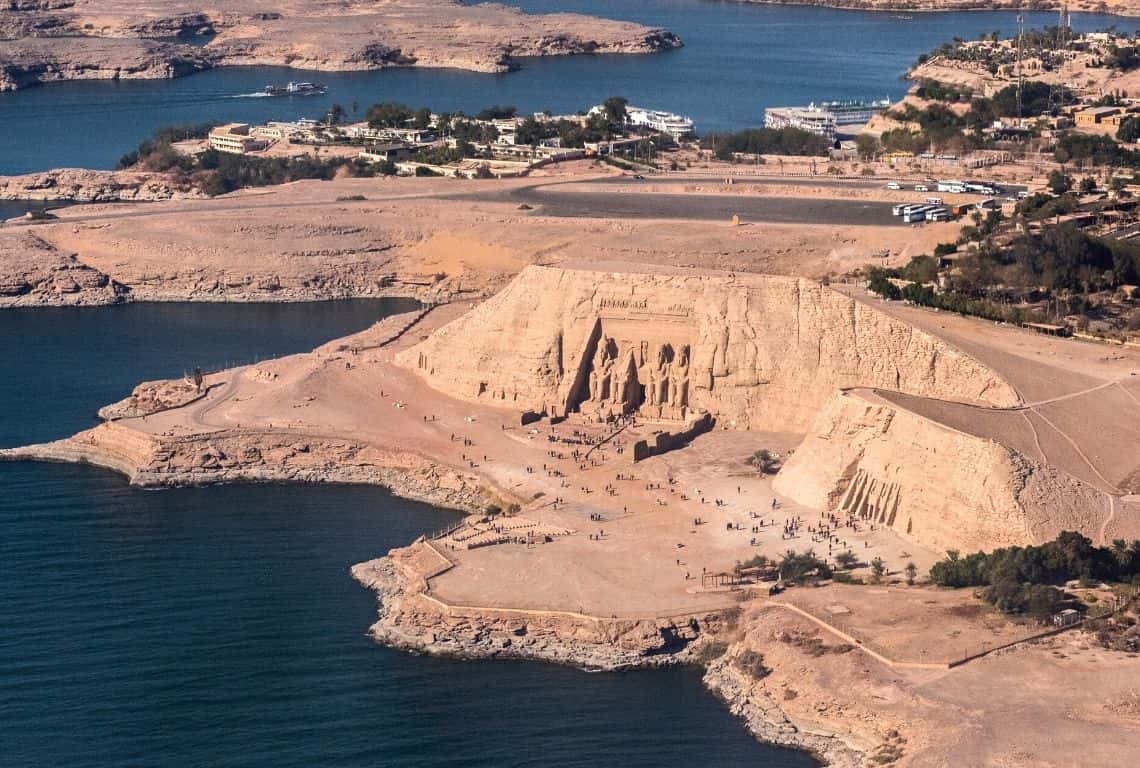
The Abu Simbel Temple Complex is located southwest of Aswan or Luxor at Abu Simbel village in Aswan Governorate, Upper Egypt. Specifically, it is situated 287 km (178 mi) from Aswan and 499 km (310 mi) from Luxor / How to Visit and What to See at Abu Simbel
How to Get to Abu Simbel from Aswan or Luxor
- How to Get to Abu Simbel from Aswan
To be frank, the best way to get to Abu Simbel from Aswan is by driving. It can be done by either hiring a private car (or a minibus) or taking a taxi.
I hired a tour guide and a minibus with two drivers. Yes, two drivers. Apparently, it is required to have one main driver and one backup driver for long(er) trips.
It took me roughly 3 hours to reach Abu Simbel from Aswan.
The condition of the road leading to Abu Simbel is pretty good minus a few occasional potholes and some speed bumps, and a couple of army and police checkpoints. As far as the landscape, it is rather monotonous with the desert all around you.
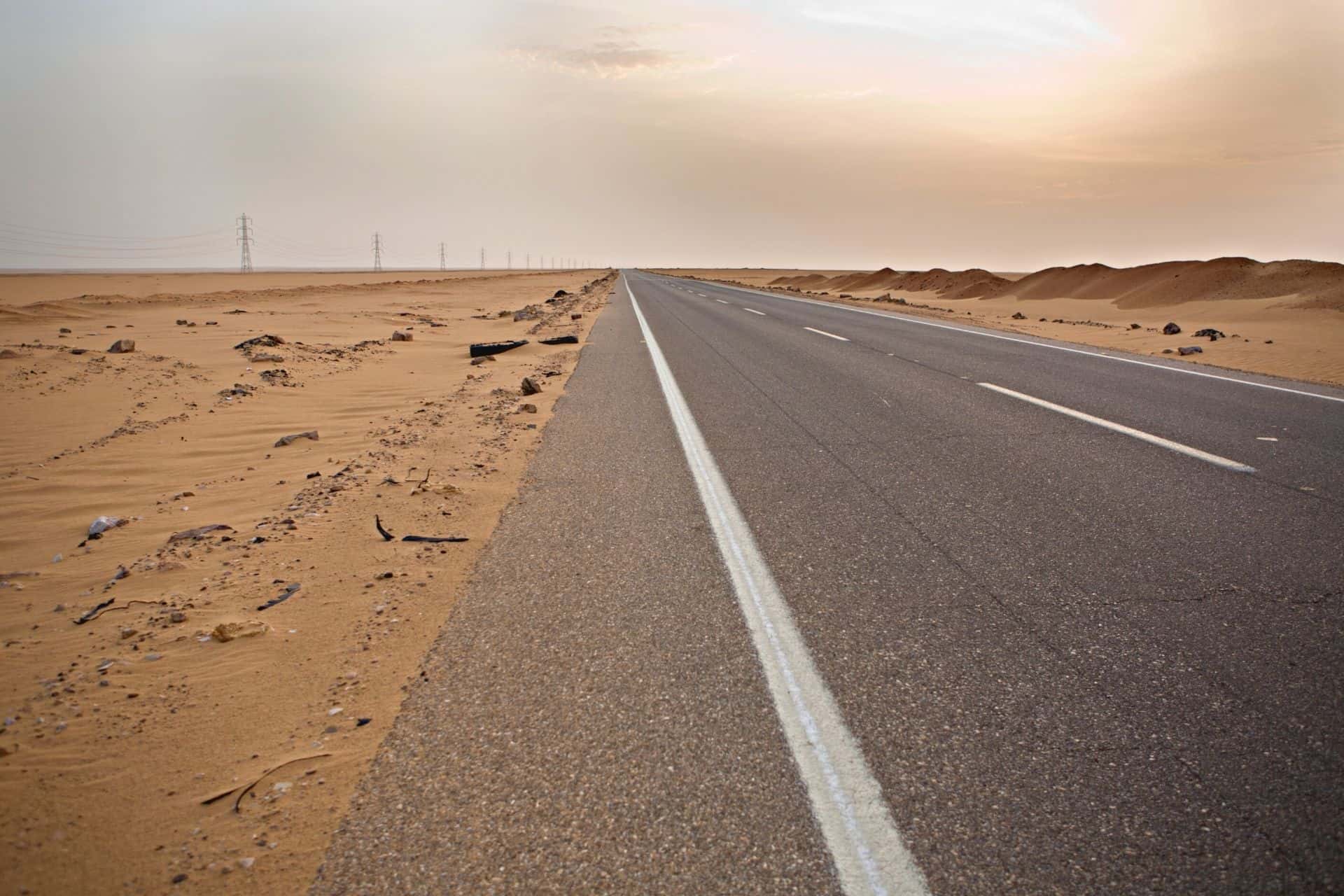
The condition of the road leading to Abu Simbel is pretty good. As far as the landscape, it is rather monotonous with the desert all around you / How to Visit and What to See at Abu Simbel
Another way to reach Abu Simbel is by plane. The only takes 45 minutes to fly from Aswan to Abu Simbel. The flights are operated by either EgyptAir or Air Cairo. However, a little bit of advance planning is necessary because the flights are only available on Wednesdays, Thursdays, and Fridays. Unfortunately, there are no scheduled flights on Saturdays and Sundays.
- How to Get to Abu Simbel from Luxor
The best way to get to Abu Simbel from Luxor is to fly. However, keep in mind, that there are no direct flights from Luxor to Aswan and you will have a stopover in Aswan.
Another way to reach Abu Simbel from Luxor is by driving. It will take you about 6 hours to get to Abu Simbel.
Is It Safe to Visit Abu Simbel
My visit to Abu Simbel was perfect! I had a private minibus, two drivers, and a tour guide. As I said before, I was required to have two drivers. The second one was the backup.
The journey to visit Aswan took me about 3 hours. And, I spent the entire time talking and listening to my tour guide. I did not feel unsafe at any time. We had to stop a couple of times at different checkpoints, which took just a few minutes at each checkpoint. I did not have to show my passport or any documents. The main driver conversed with the guards at each checkpoint and we smoothly moved along.
Do You Need a Guide for Abu Simbel
Tour guides are not allowed inside the Abu Simbel Temple Complex. So, you might be wondering if you really need to hire a tour guide for your visit to Abu Simbel. It is your choice.
However, a 3-hour trip from Aswan to Abu Simbel or a 6-hour trip from Luxor to Abu Simbel is a perfect way to learn all about the history of Egypt and the history of the temples by having a tour guide with you.
My tour guide used the 3-hour time window to talk to me about the history of Abu Simbel, and the history of Egypt, as well as give me many pointers as to what to pay attention to while I visit the Abu Simbel Temple Complex.
I usually read a ton of stuff before I venture out anywhere. However, a knowledgeable guide is priceless!
What You Need to Know About Abu Simbel Temple Complex Before You Visit
How Old Is Abu Simbel Temple Complex
The Abu Simbel Temple Complex consists of two temples: the Great Temple built to honor Ramses II and the Small Temple constructed to honor Ramesses II’s chief consort, Nefertari. The Abu Simbel Temple Complex was completed in 1244 BC.
Why Was Abu Simbel Complex Built
There are several reasons why Ramses II built Abu Simbel Temple Complex:
- First of all, he built the Great Temple to recognize and honor himself and to dedicate it to the god Ra-Horakhty. And, he built the Small Temple as a monument to his beloved queen, Nefertari, and dedicated it to the goddess Hathor.
- Second, Ramses II wanted to commemorate his victory at the Battle of Kadesh. The reliefs depicting him conquering his enemies are throughout the Great Temple. If you look closely, you will see that even the base of the temple was carved with figures of his conquered enemies: the Libyans, the Nubians, and the Hittites.
- And, lastly, Ramses II wanted to impress Egypt’s neighbors, the Nubians.
Why Is the Great Temple of Abu Simbel Important
The temples of Abu Simbel were carved out of solid rock. They impress even now! For me, it was a breathtaking sight!
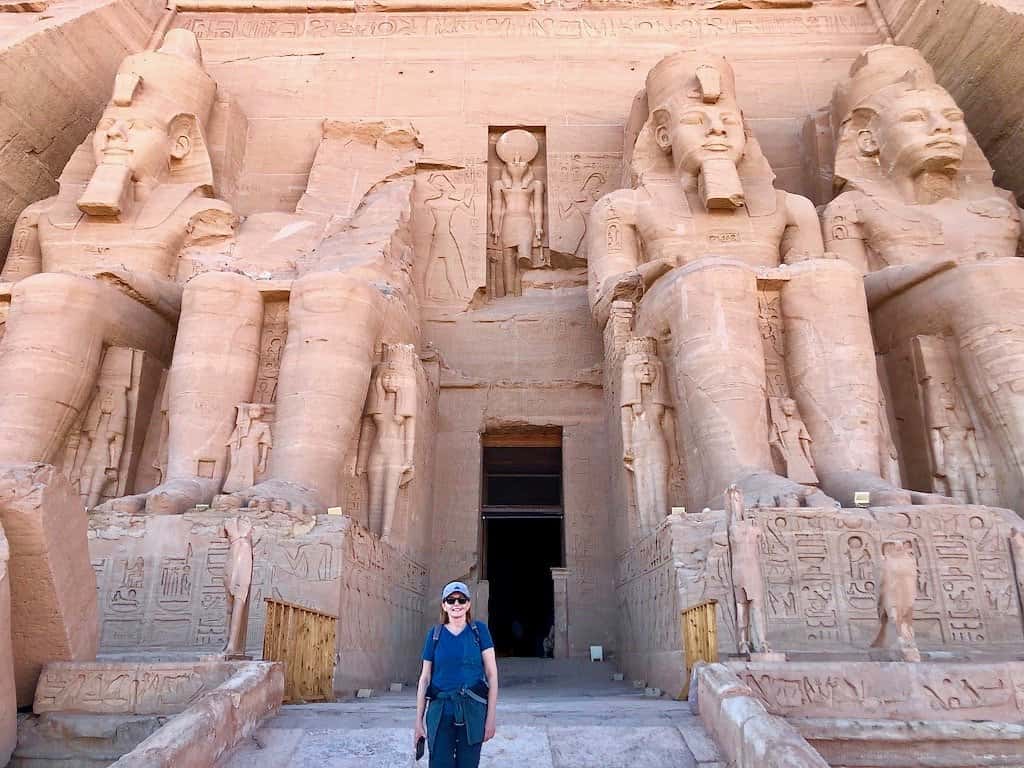
The temples of Abu Simbel were carved out of solid rock / How to Visit and What to See at Abu Simbel
First of all, the facade of this structure is incredible! It is 35 meters (115 feet) long and 30 meters (98 feet) high.
Next, the entrance to the temple is flanked by four enthroned colossal statues of Ramses II. Each statue is 20 meters (65 feet) high. If you look closely at the statues, you will notice that they are adorned with a double crown, which symbolizes the unity of Upper and Lower Egypt.
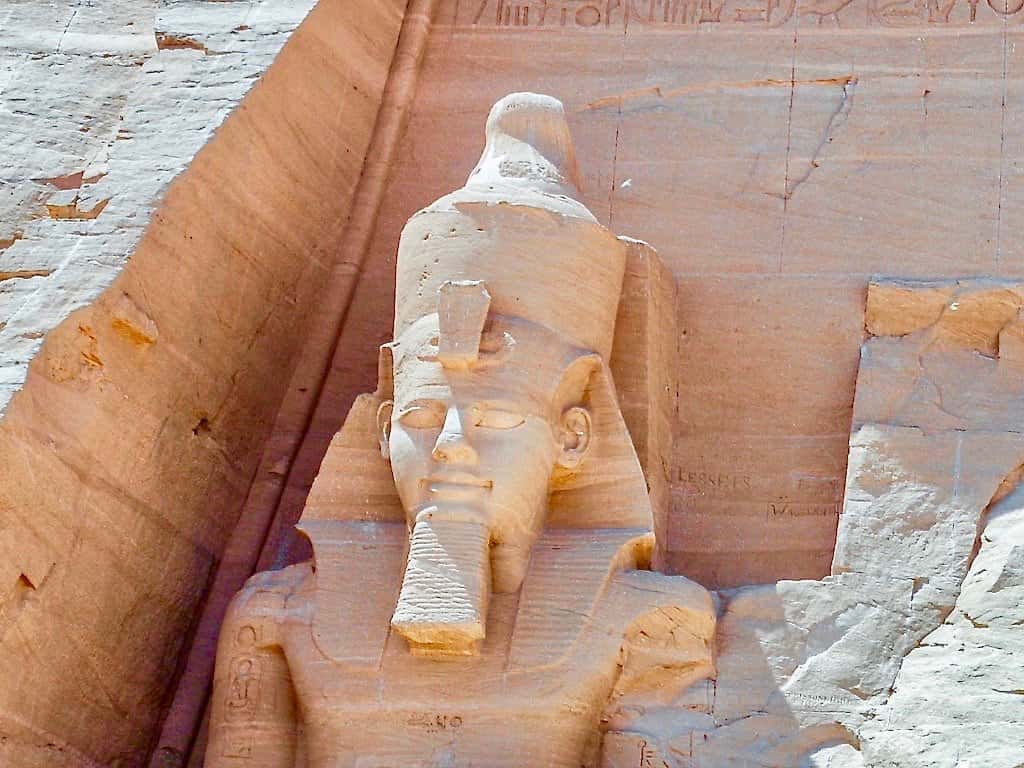
The statues are adorned with a double crown, which symbolizes the unity of Upper and Lower Egypt / How to Visit and What to See at Abu Simbel
Moreover, each figure has a vertical cartouche on its right arm with Ramses II’s name.
What is a cartouche? A cartouche is an oval with a horizontal line under one of the ends. It indicates that the enclosed text is a royal name. By the way, cartouches were formerly only worn by Pharaohs. The oval surrounding their name was meant to protect them from evil spirits in life and after death.
Interestingly enough, the word ‘cartouche’ comes from the French language and means paper powder cartridge. Apparently, French soldiers stationed in Egypt saw a resemblance between the oval shapes and the paper powder cartridges and hence, the name cartouche.
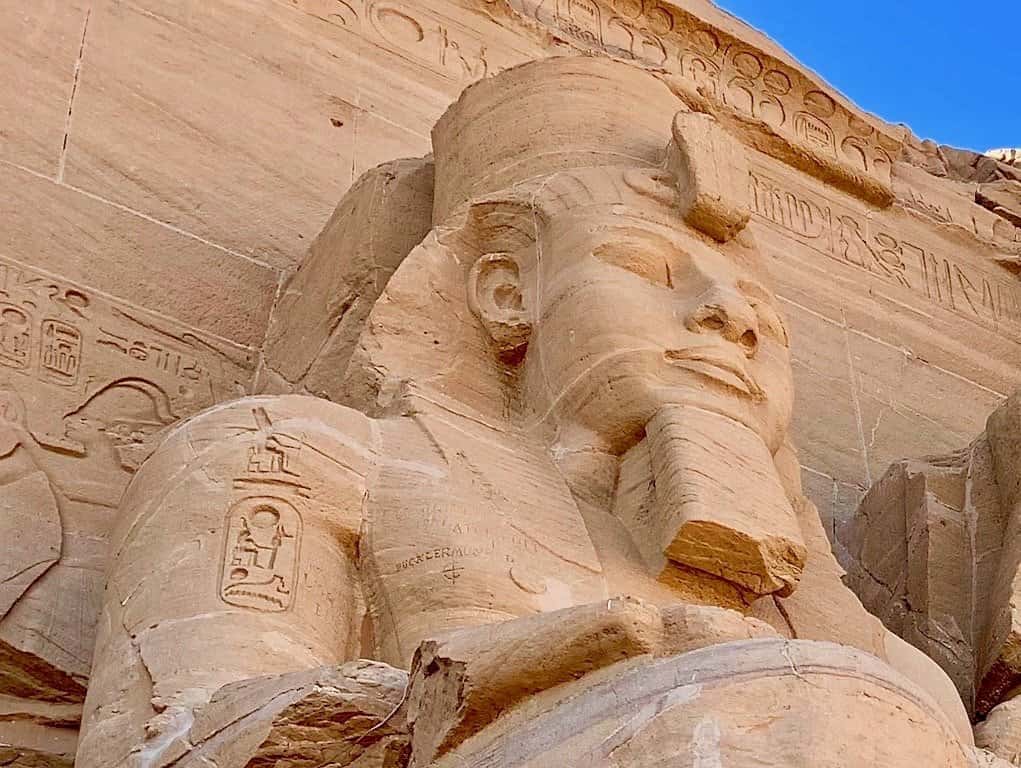
Cartouches were formerly only worn by Pharaohs. The oval surrounding their name was meant to protect them from evil spirits in life and after death / How to Visit and What to See at Abu Simbel
One of the statues lost its head and torso in an earthquake in 27 BC.
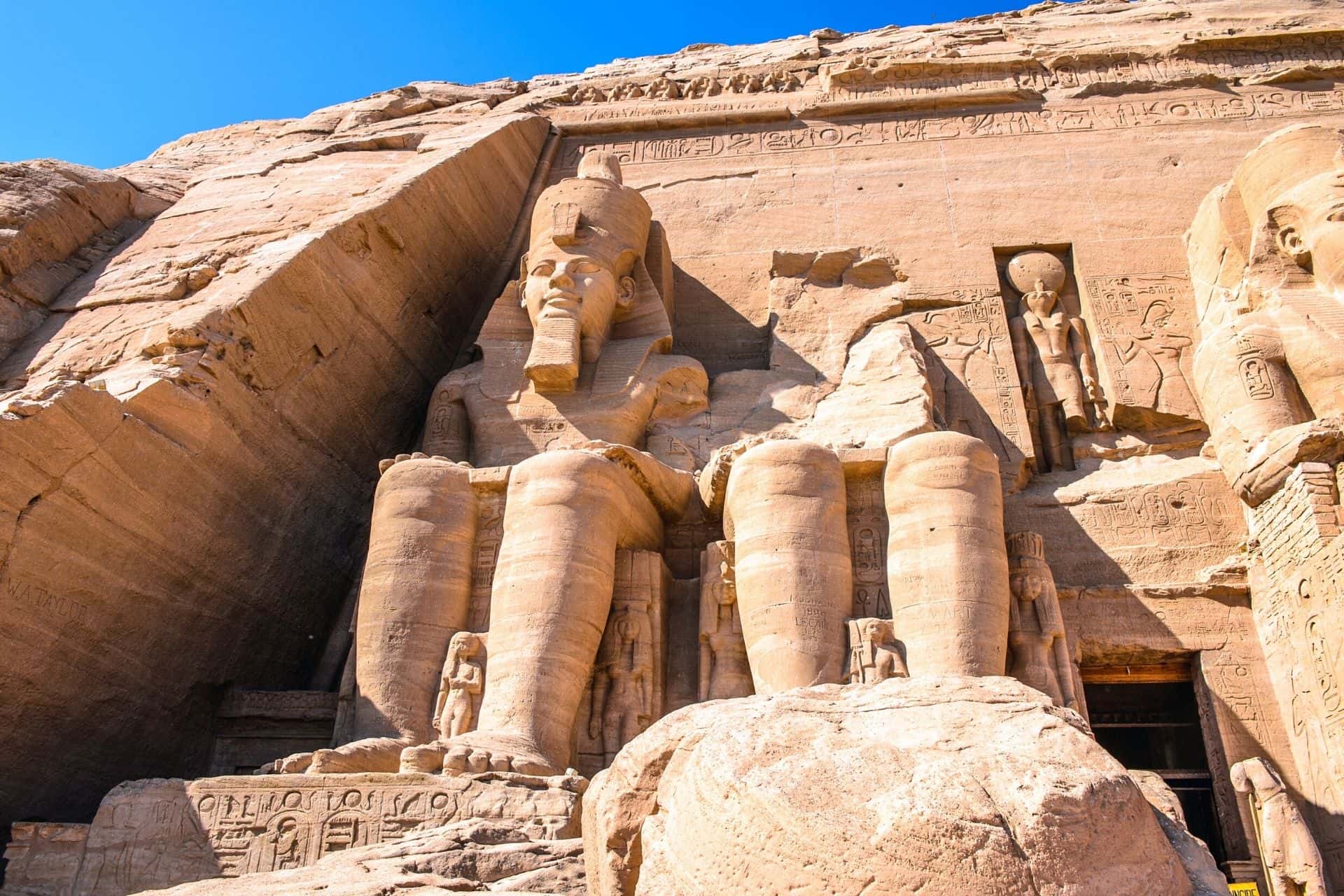
One of the statues lost its head and torso in an earthquake in 27 BC / How to Visit and What to See at Abu Simbel
On the bottom and around the knees of the statues are figures of some of Ramses II’s wives and children / How to Visit and What to See at Abu Simbel
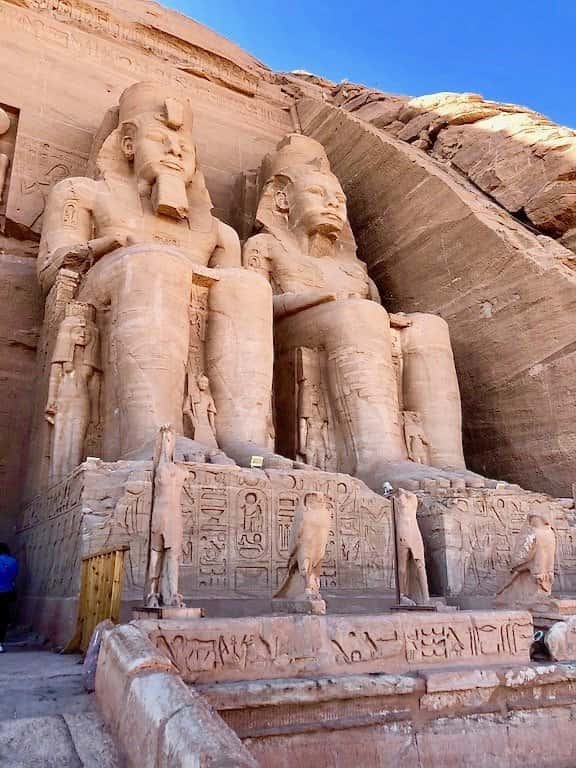
On the bottom and around the feet of the statues of Ramses II are figures of his wives and children / How to Visit and What to See at Abu Simbel
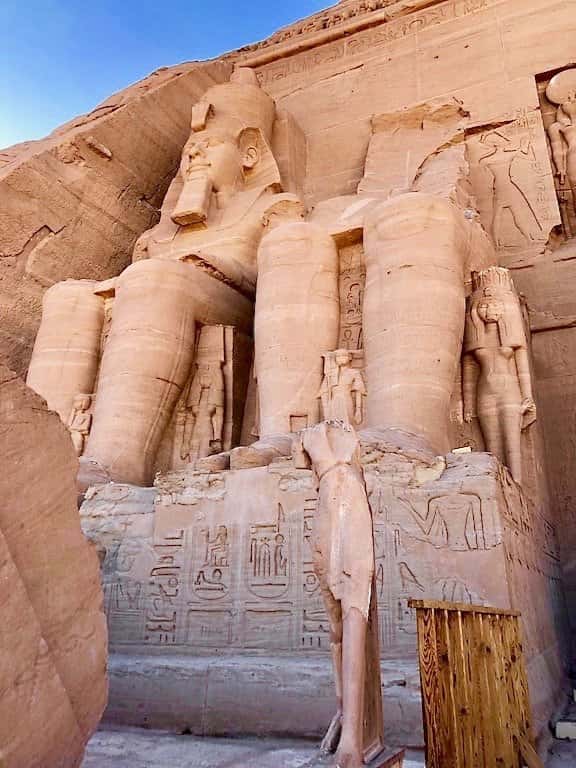
One of the statues of Rames II lost its head and torso in an earthquake in 27 BC / How to Visit and What to See at Abu Simbel
Next, take a look at the statue right above the entrance to the temple. It is the figure of the god Ra-Harakhty, to whom Ramses II dedicated the temple.
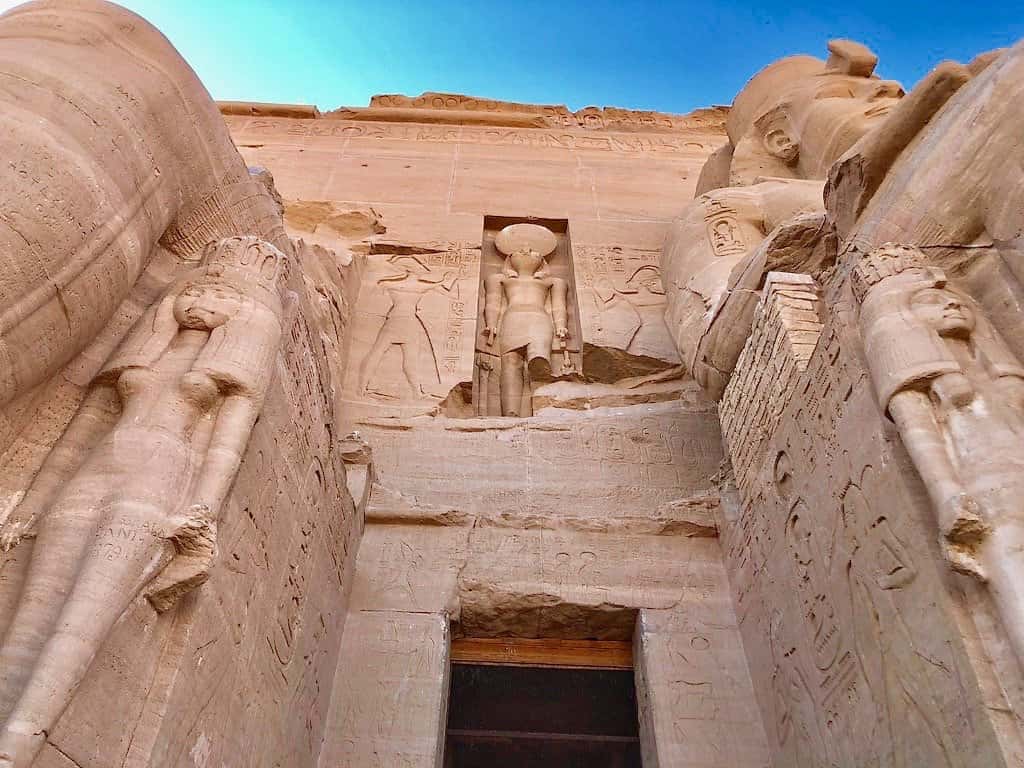
The figure of the god Ra-Harakhty, to whom Ramses II dedicated the temple, is above the entrance to the Great Temple / How to Visit and What to See at Abu Simbel
Once you cross the entrance, you will find yourself in Hypostyle Hall. It is an incredible sight!
There are four pillars on each side with colossal statues of Ramses II. Each statue is 10 meters (33 feet) high.
The statues on the left-hand side wear the Upper Egypt crown, while the statues on the right-hand side wear the double crown of Upper and Lower Egypt.
Inside the Great Temple of Abu Simbel / How to Visit and What to See at Abu Simbel
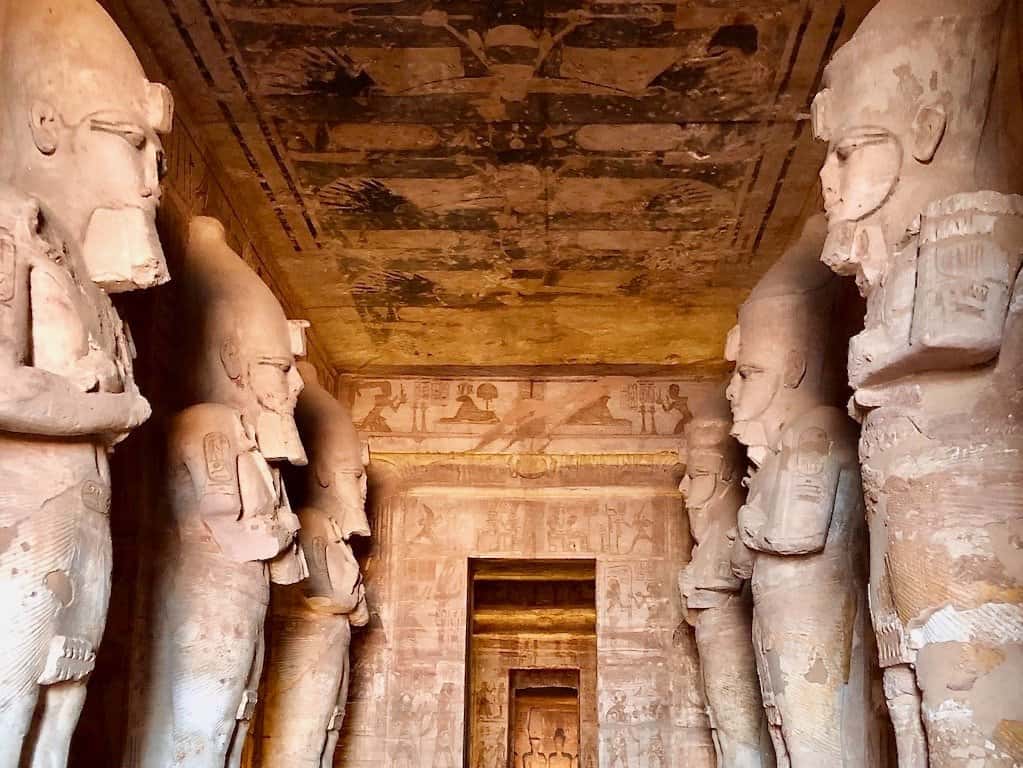
Once you cross the entrance, you will find yourself in Hypostyle Hall. It is an incredible sight! / How to Visit and What to See at Abu Simbel
Ramses II is represented as the god Osiris holding the crook and flail. The crook represents the kingship and the flail stands for the fertility of the land.
Who was Osiris? Osiris was the god of the dead, and ruler of the underworld. He was portrayed as a mummified man wearing a white cone-like headdress with feathers
Osiris was the brother and husband of Isis and the brother of Nephthys and Seth. He was also the father of Horus.
As well as being a god of the dead, Osiris was a god of resurrection and fertility. In fact, the ancient Egyptians believed that Osiris gave them the gift of barley, one of their most important crops.
Source: Ancient Egypt
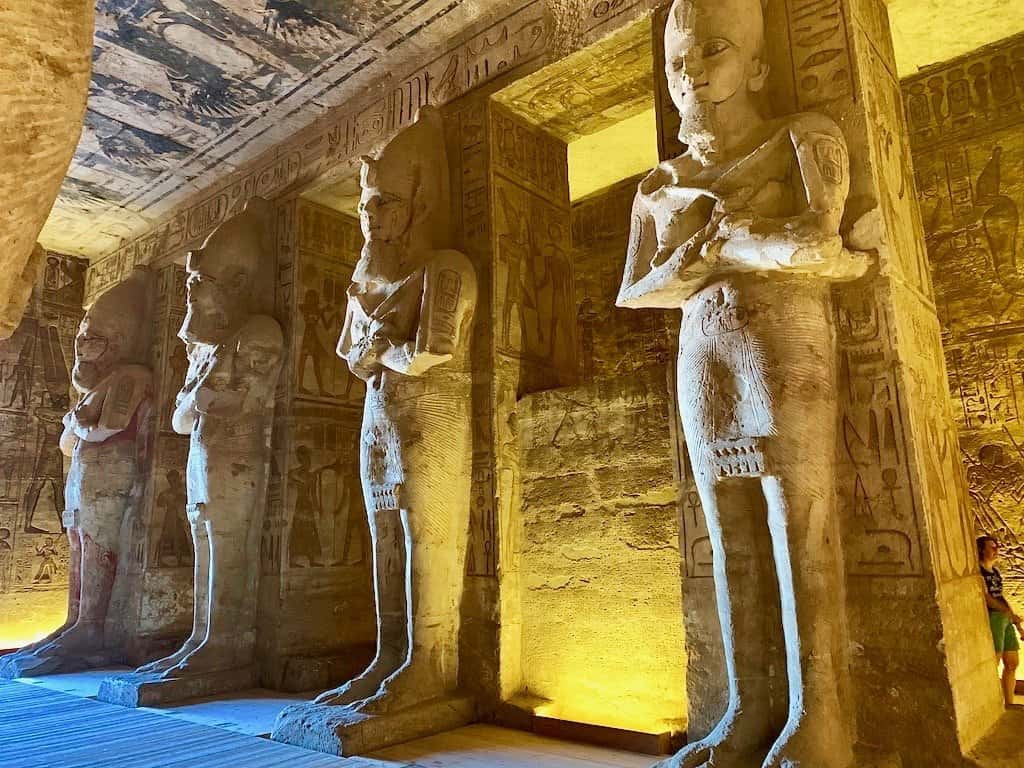
Ramses II is represented as the god Osiris holding the crook and flail. The crook represents the kingship and the flail stands for the fertility of the land / How to Visit and What to See at Abu Simbel
The walls of the Hypostyle Hall are decorated with reliefs commemorating Ramses II’s victory at the Battle of Kadesh.
As well as, images of Ramses II making offerings to his gods.
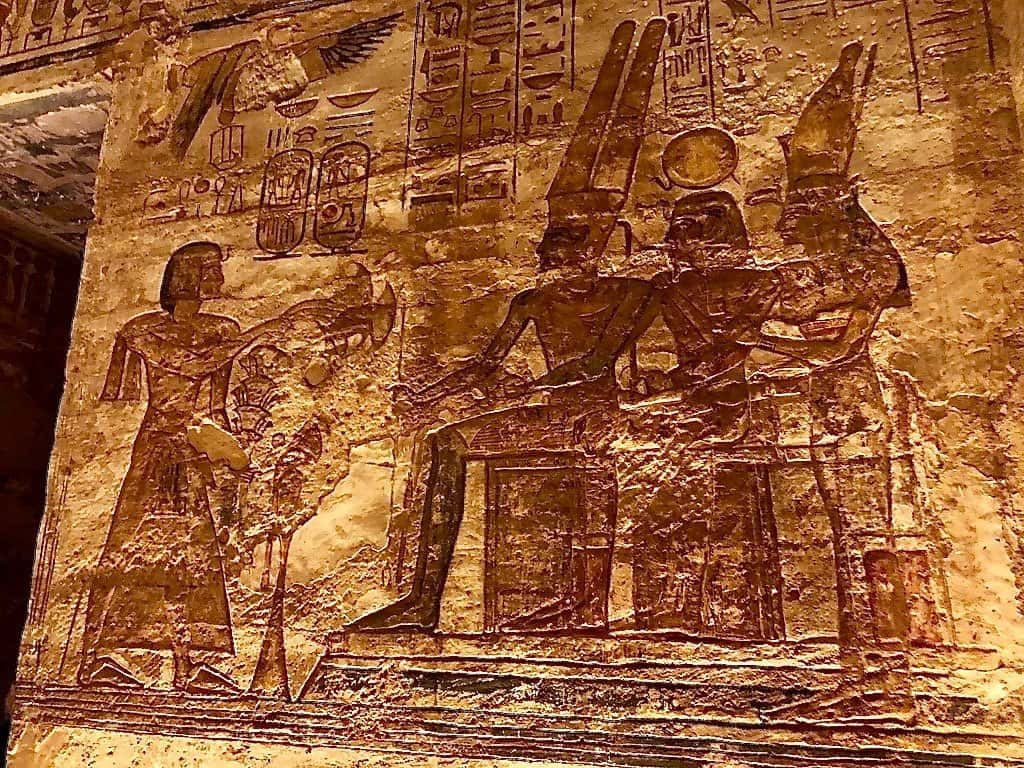
Reliefs of Ramses II making offerings to his gods / How to Visit and What to See at Abu Simbel
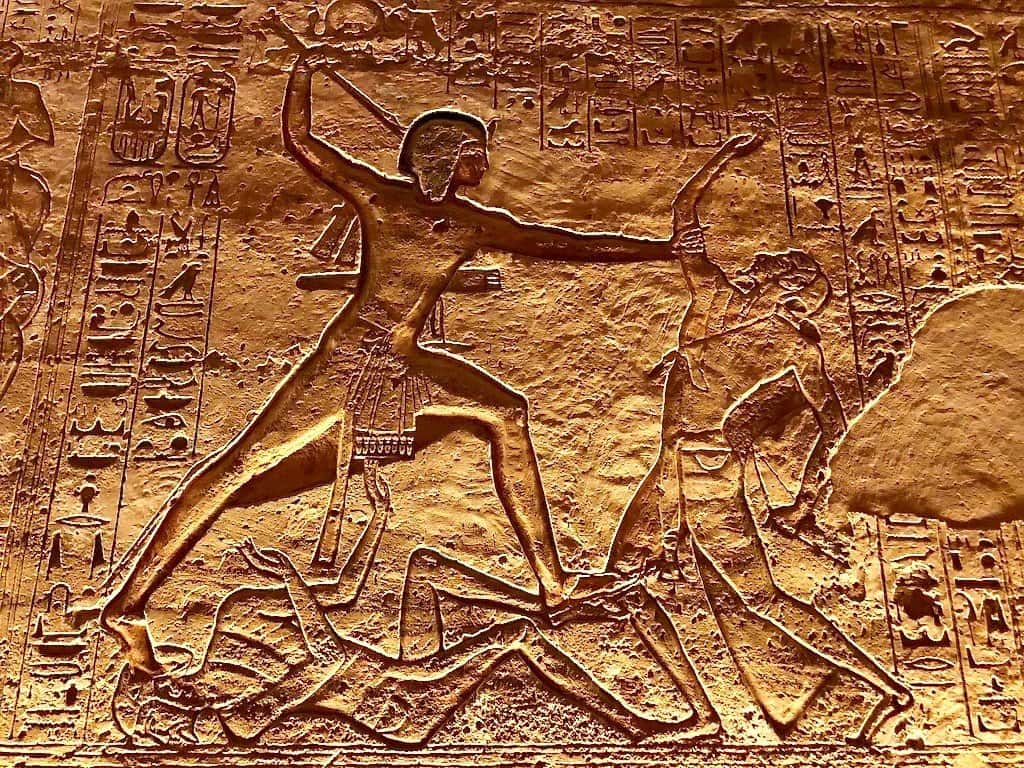
Reliefs commemorating Ramses II’s victory at the Battle of Kadesh / How to Visit and What to See at Abu Simbel
On each side of the Hypostyle Hall are storerooms with beautifully decorated walls. Here, the offerings to the gods were kept and ritual items were stored.
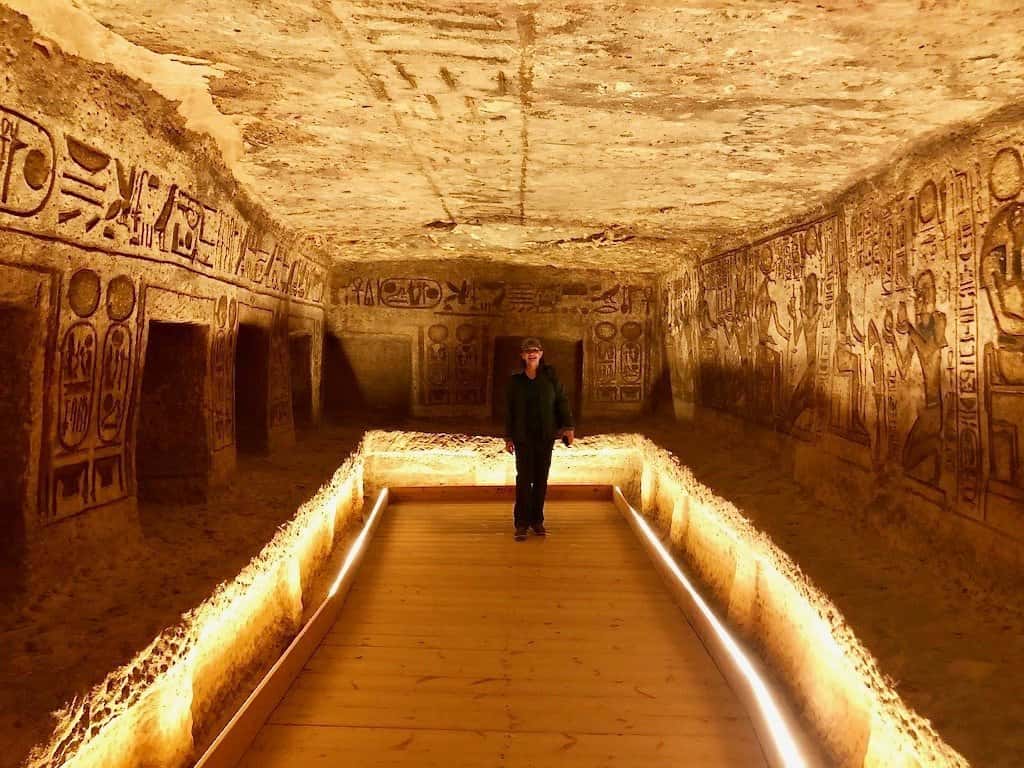
On each side of the Hypostyle Hall are storerooms with beautifully decorated walls / How to Visit and What to See at Abu Simbel
What is Abu Simbel Famous For
The Great Temple of Abu Simbel is famous for being built along the sun’s axis.
As a result, twice a year, on February 22 and October 22, the sunlight reaches 55 meters (180 feet) into the innermost room of the temple and illuminates three of the four sitting statues.
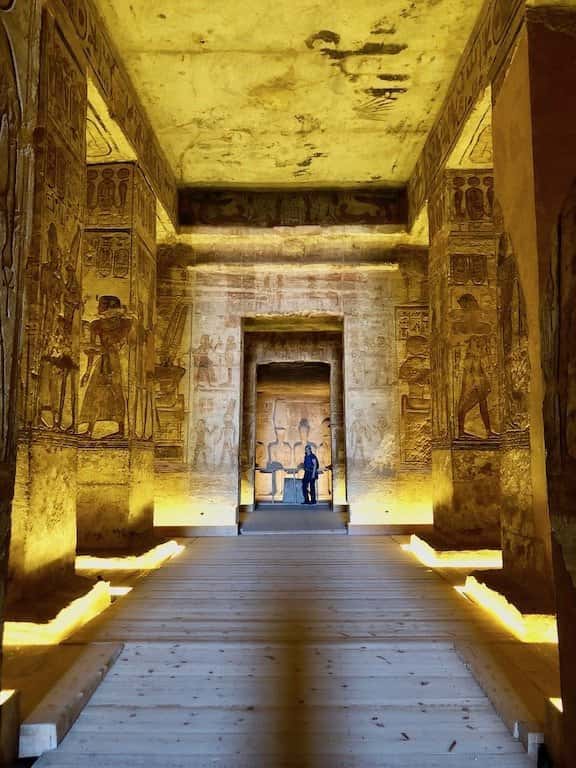
The Great Temple of Abu Simbel is famous for being built along the axis of the sun / How to Visit and What to See at Abu Simbel
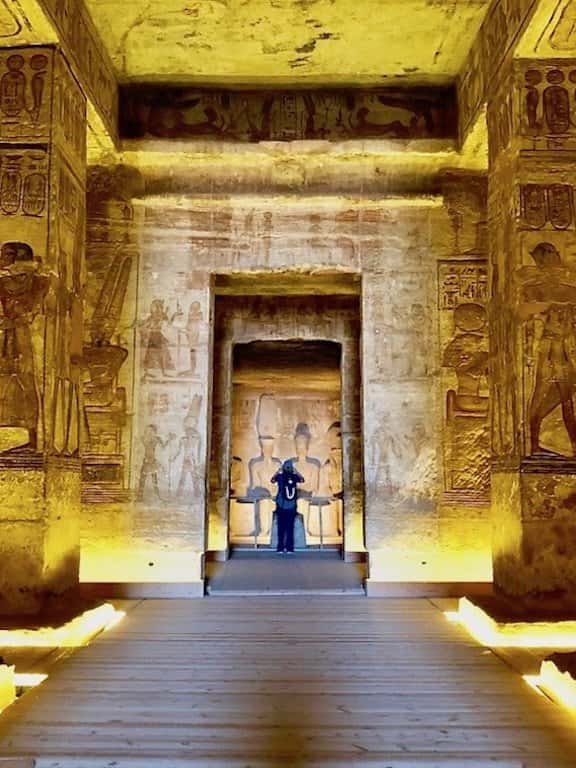
twice a year, the sunlight reaches the innermost room of the temple and illuminates three of the four sitting statues / How to Visit and What to See at Abu Simbel
When the rays of the sun reach the sitting statues, three of the four states are illuminated for about 10 minutes.
First, the statue of Ra is illuminated, then the statue of Amun, and finally the light reaches the statue of Rameses II. However, the fourth statue of the god Ptah remains in the dark.
Ra was the king of the deities and the father of all creation. He was the patron of the sun, heaven, kingship, power, and light. He was not only the deity who governed the actions of the sun, he could also be the physical sun itself, as well as the day.
Amun, a god of the air, was one of the eight primordial Egyptian deities. Amun’s role evolved over the centuries; during the Middle Kingdom he became the King of the deities and in the New Kingdom he became a nationally worshipped god. He eventually merged with Ra, the ancient sun god, to become Amun-Ra.
Ptah, the god whose breath was said to give life to everything at the beginning. As the god who created all the other deities, Ptah is worshipped as the patron of craftspeople and architects. He is credited with inventing masonry. The famed architect Imhotep claimed to be his offspring.
Source: Egyptian Museum
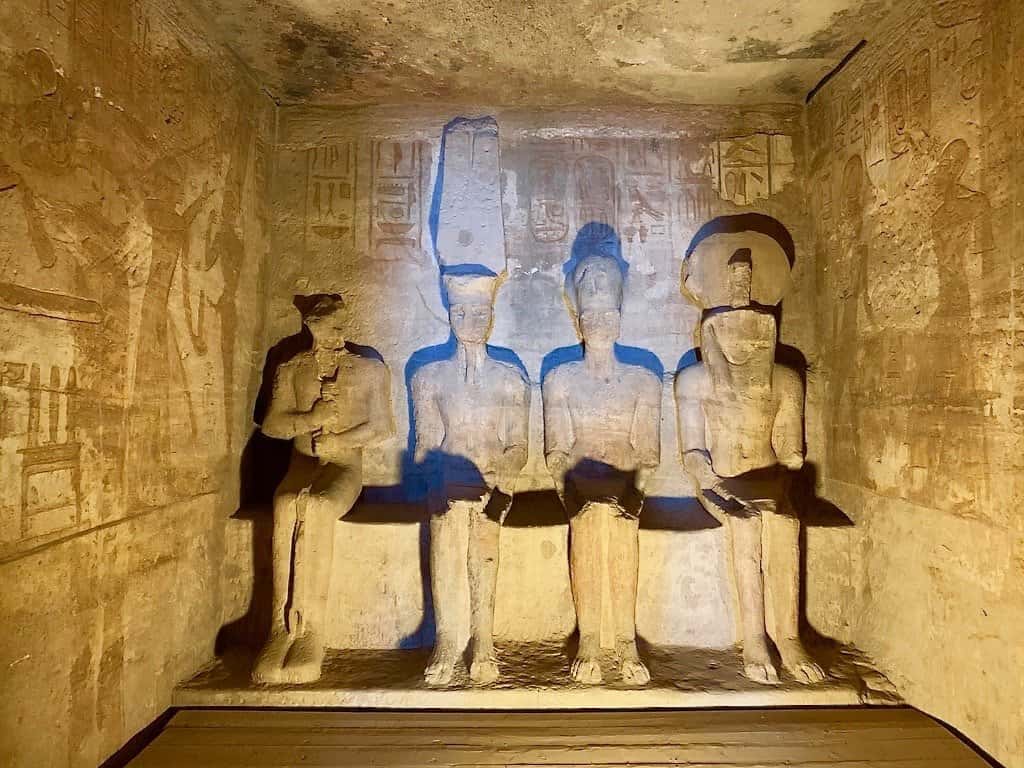
When the rays of the sun reach the sitting statues, three of the four states are illuminated for about 10 minutes / How to Visit and What to See at Abu Simbel
I did a lot of research as to the significance of the sun entering the inner sanctum on these two specific days: February 22 and October 22. However, all I could find was the speculation, that these two dates were the birthday and coronation of Ramses II.
Why is the Small Temple of Abu Simbel Important
Next to the Great Temple of Abu Simbel, sits the Small Temple. It was built by Ramses II for his wife Nefertari and dedicated to the goddess Hathor.
It is an important temple for several reasons:
- First of all, if you look at the facade of the Small Temple, you will notice that it is adorned with six colossal statues of Queen Nefertari as goddess Hathor and Ramses II. Specifically, there are four figures of Ramses II and two of Queen Nefertari. And, all the statues are the same size! Notably, it is the first time, that the statue of a wife was carved the same size as the statue of the Pharaoh himself. Usually, the statues of wives and children are never higher than the Pharaoh’s knees.
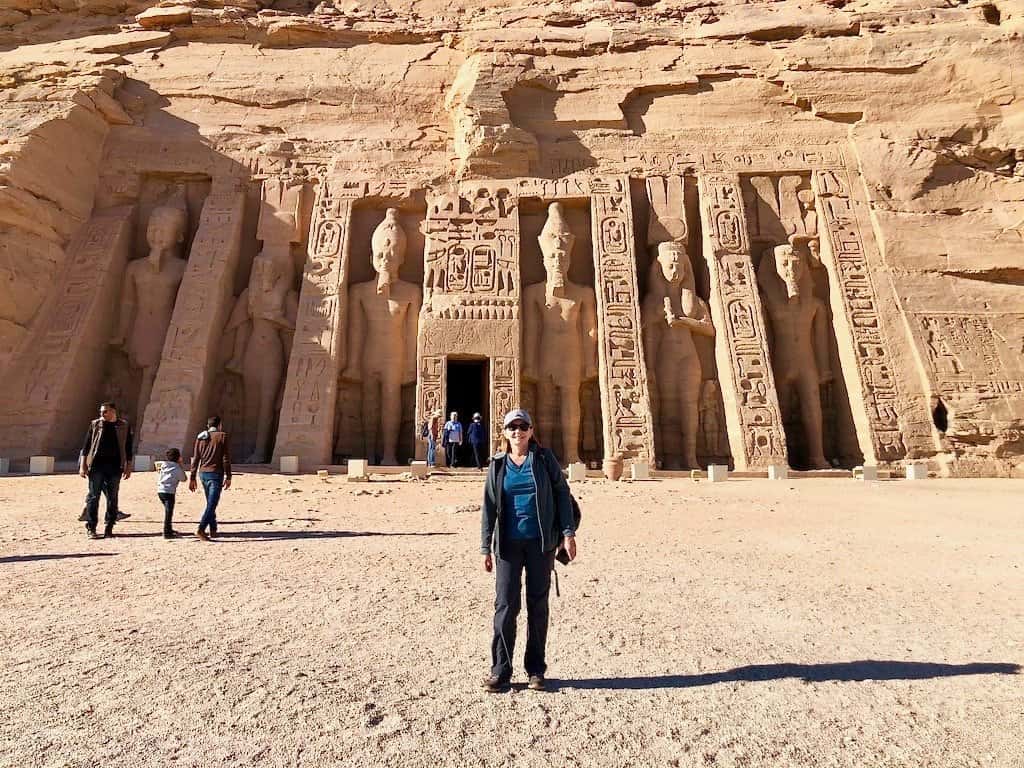
If you look at the facade of the Small Temple, you will notice that it is adorned with six colossal statues of Queen Nefertari as goddess Hathor and Ramses II / How to Visit and What to See at Abu Simbel
- Second, the Small Temple was dedicated to a wife. A Pharaoh would have many other wives and concubines. However, this temple Ramses II dedicated to his first wife. Also, interestingly enough, the statues of Ramses II and Nefertari’s daughters are depicted as taller than their sons. It is possible, that the temple was dedicated to all the women within his family.
But, it is not the first time the Pharaoh dedicated a temple to his wife. The first temple was built by Akhenaten for his wife Nefertiti.
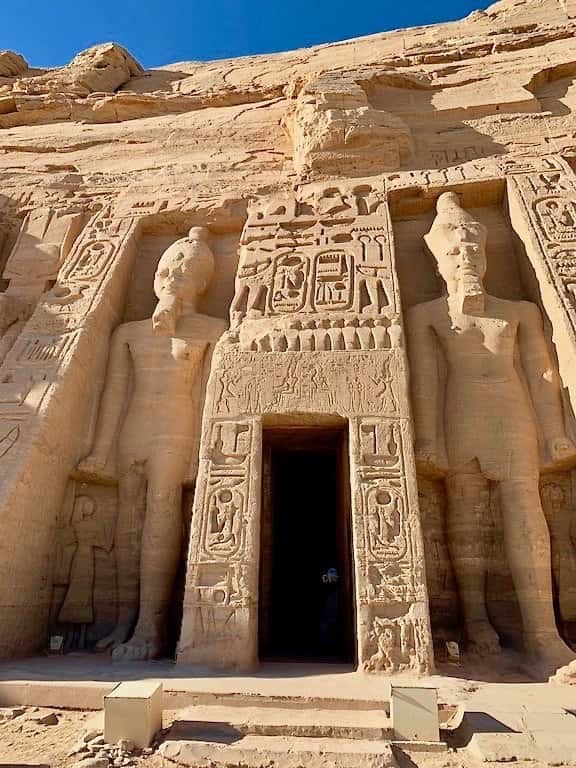
All the statues are the same size! Notably, it is the first time ever, that the statue of a wife was carved the same size as the statue of the Pharaoh himself / How to Visit and What to See at Abu Simbel
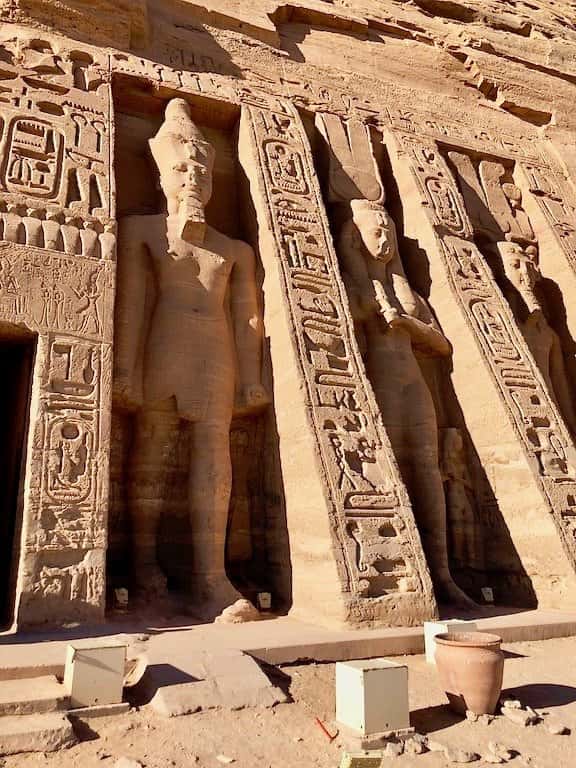
The statues of Ramses II and Nefertari’s daughters are depicted as taller than their sons. It is possible, that the temple was dedicated to all the women within his family / How to Visit and What to See at Abu Simbel
As you step inside, you will find yourself inside a large hall supported by six pillars.
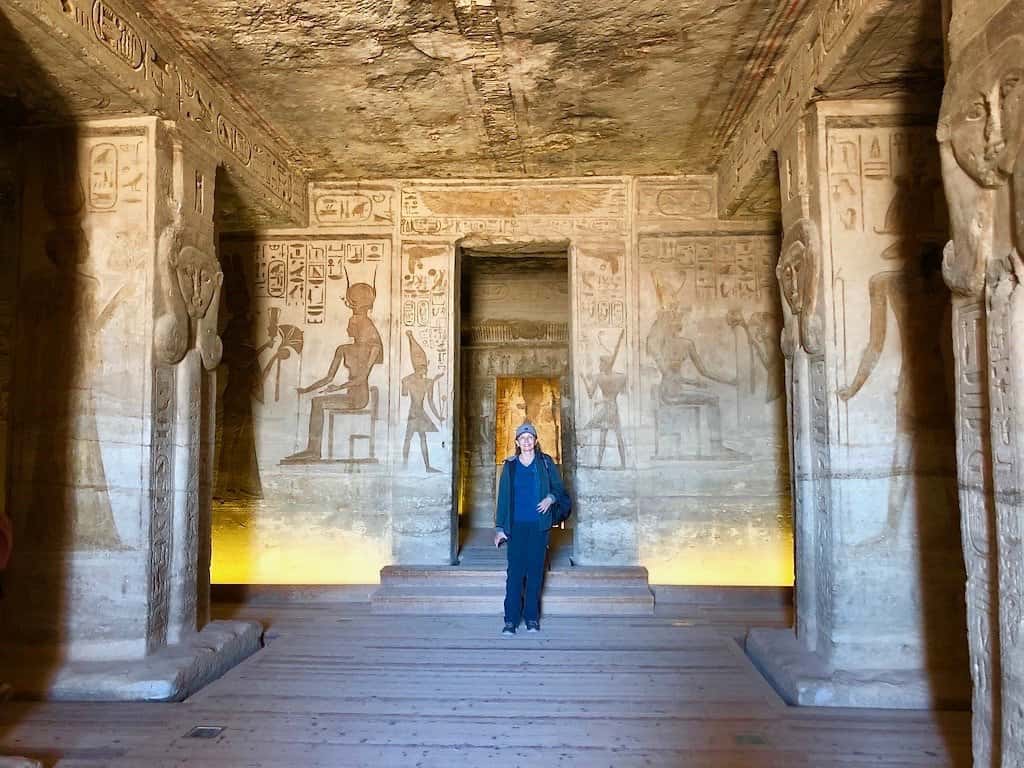
The Small Temple has a large hall supported by six pillars / How to Visit and What to See at Abu Simbel
Each pillar has the head of the goddess Hathor carved on top of it.
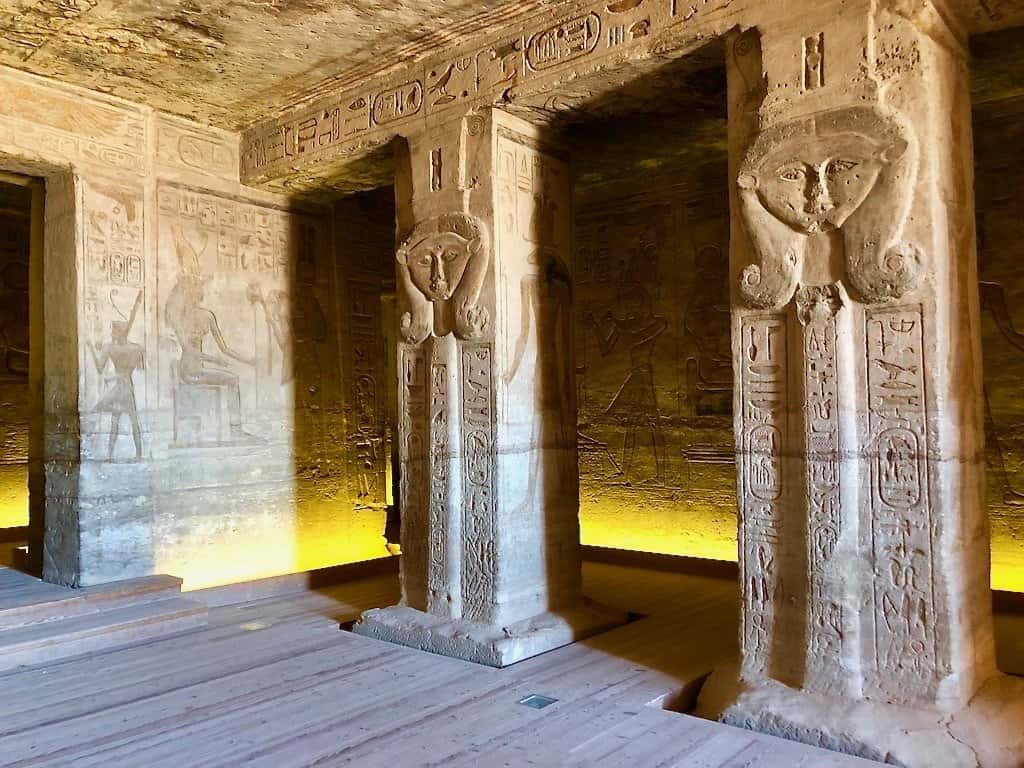
Each pillar has the head of the goddess Hathor carved on top of it / How to Visit and What to See at Abu Simbel
The walls are decorated with scenes showing Ramses II and Queen Nefertari making offerings to various Egyptian gods.
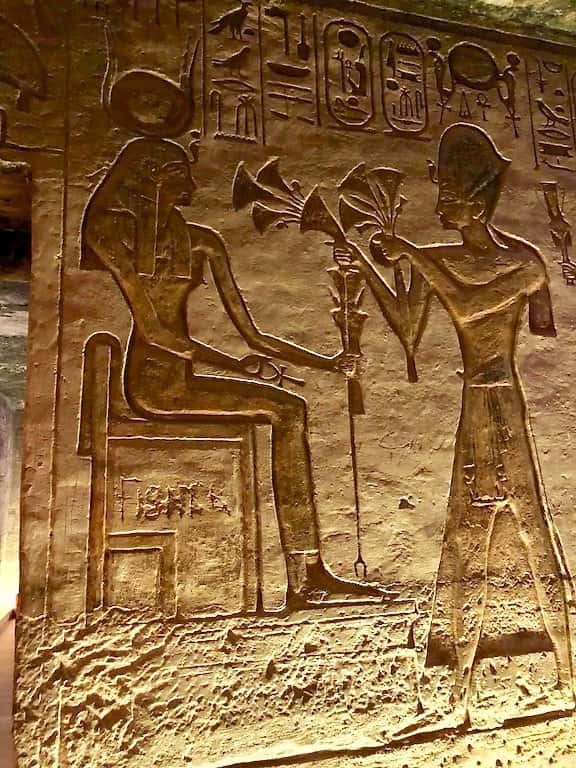
The beautiful wall decorations at the Small Temple at Abu Simbel / How to Visit and What to See at Abu Simbel
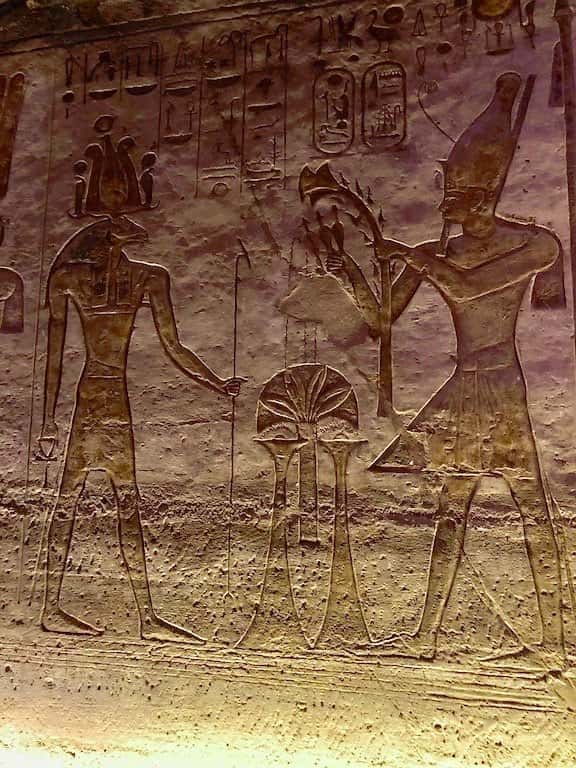
The beautiful wall decorations at the Small Temple at Abu Simbel / How to Visit and What to See at Abu Simbel
Who Discovered Abu Simbel
As time went by, the Abu Simbel Temple Complex stopped being used. Gradually, the temples were covered by desert sand. And, stayed buried in the sand for centuries.
The temple’s facade was discovered in 1811 by Swiss orientalist Jean-Louis Burckhardt (also known as John Lewis, Jean Louis). Burckhardt talked about his discovery with Italian explorer Giovanni Belzoni.
Belzoni traveled to the site, however, he was unable to dig out an entry to the temple. Belzoni returned in 1817 and this time, he succeeded in entering the temples.
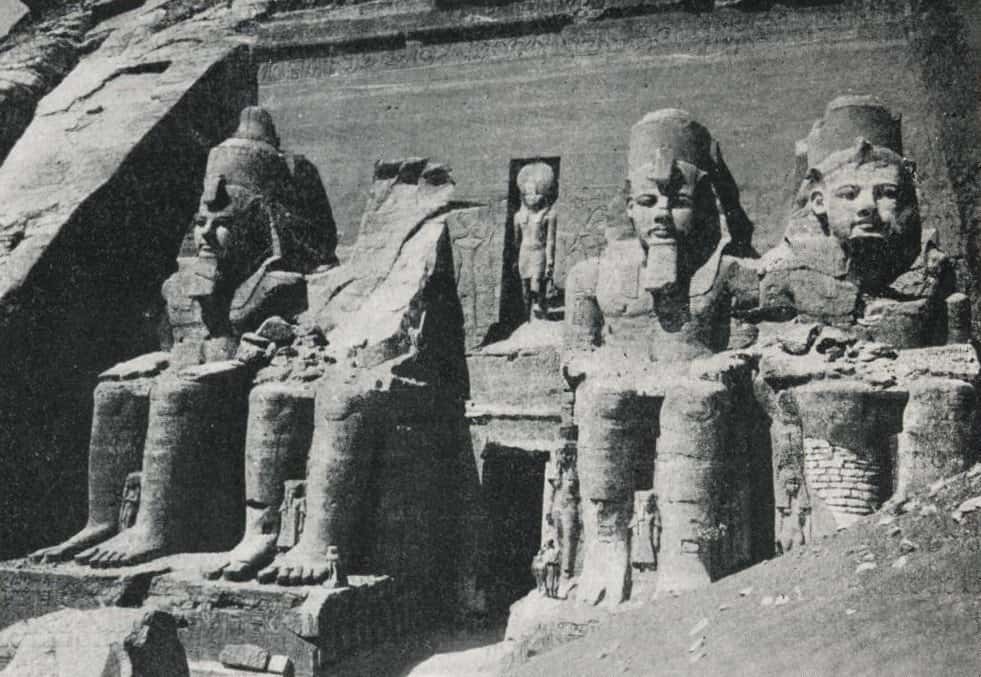
The temple’s facade was discovered in 1811 by Swiss orientalist Jean-Louis Burckhardt (also known as John Lewis, Jean Louis). Burckhardt talked about his discovery with Italian explorer Giovanni Belzoni. Image Credit: Wikimedia /How to Visit and What to See at Abu Simbel
Why Was Abu Simbel Moved
Abu Simbel Temple Complex was constructed 280 km (174 miles) southwest of Aswan.
In the 1960s, the decision was made to build the Aswan High Dam on the River Nile. After the building of the dam, a massive artificial water reservoir was formed. It is known today as Lake Nasser. The purpose of building the dam was to better control the floods of the River Nile and to generate electricity for Egypt.
However, the creation of Lake Nasser threatened to engulf the temples. The relocation of the Abu Simbel Temple Complex was the only way of saving the structures.
On January 9, 1960, three months after construction began on the dam, UNESCO launched a worldwide call for help.
‘The salvage of the Abu Simbel temples began in 1964 by a multinational team of archeologists, engineers, and skilled heavy equipment operators working together under the UNESCO banner.
Between 1964 and 1968, the entire site was carefully cut into large blocks (up to 30 tons, averaging 20 tons), dismantled, lifted, and reassembled in a new location 65 meters higher and 200 meters back from the river, in one of the greatest challenges of archaeological engineering in history.’
Source: Wikipedia
How Was the Abu Simbel Complex Relocated
The complex was relocated in its entirety under the supervision of a Polish archaeologist, Kazimierz Michałowski.
Following is a picture of a scale model showing the original location of the Abu Simbel Temples submerged under the water. Moreover, the scale model shows the new location of the temples moved 65 meters higher and 200 meters back from Lake Nasser.
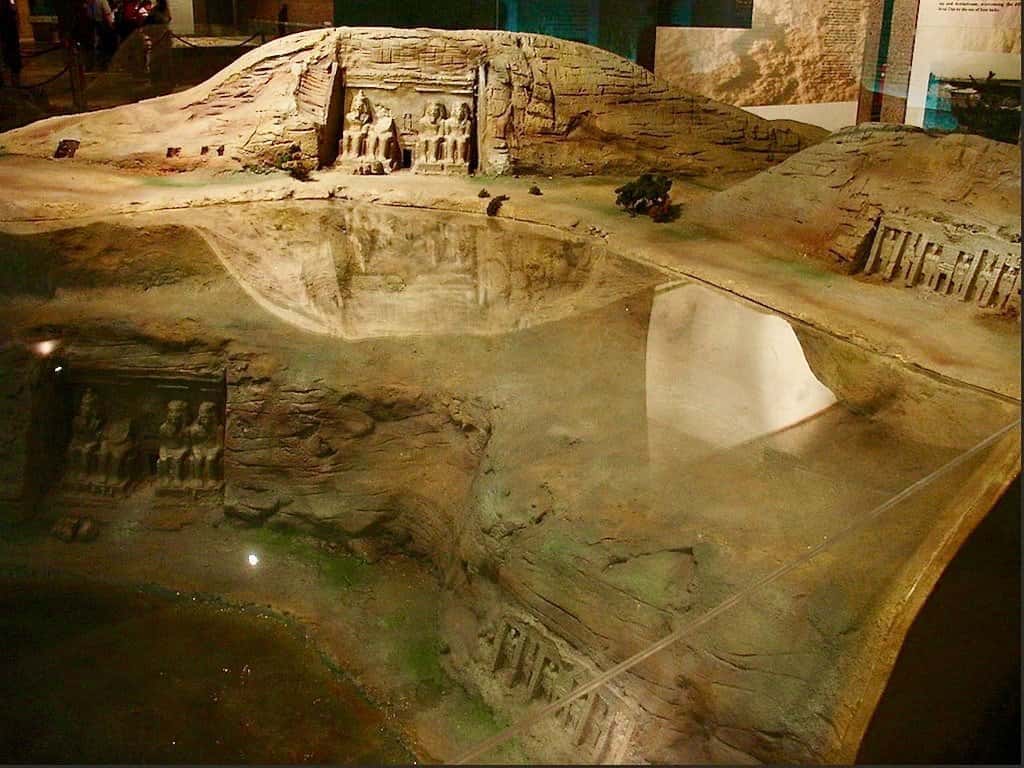
Image Credit: Wikipedia
A scale model showing the original location of the 13th century BCE Abu Simbel temples, the site submerged under reservoir water since the 1970s, and the rescued and relocated temples’ new higher sites. The photo was taken of a display at the Nubian Museum, Aswan, Egypt. Author: Zureks / How to Visit and What to See at Abu Simbel
First, a cofferdam was built around the Abu Simbel Temple Complex. The purpose of building the cofferdam was to protect the temples from the rising water of Lake Nasser.
The relocation process started with extracting the walls and ceilings of the temples from inside the mountain. The Great Temple was cut into 807 blocks and the Small Temple was cut into 235 blocks. Each and every block was marked with a number.
After having been lifted by the crane, the blocks were lowered to the storage area.
Re-erecting the roofs and the walls of the temple were the next steps in the Abu Simbel temple relocation process.
Two domes were built to cover the structure of the temple to carry the weight of the artificial hill.
Next, the statues of Ramses II were cut and moved to the place of the new temple.
Abu Simbel: Opening Hours and Cost
The Abu Simbel Temple Complex is open from 7 am to 4 pm (5 pm in the summer).
The entrance ticket to the Abu Simbel Complex costs 240 EGP.
Abu Simbel Light and Sound Show
The Abu Simbel Light and Sound Show is held at 6 pm, 7 pm, 8 pm, and 9 pm in winter and 8 pm, 9 pm, and 10 pm in summer. It is the most spectacular show I have ever seen. Don’t miss it!
Needless to say, the temples are absolutely breathtaking when lit up in the evening.
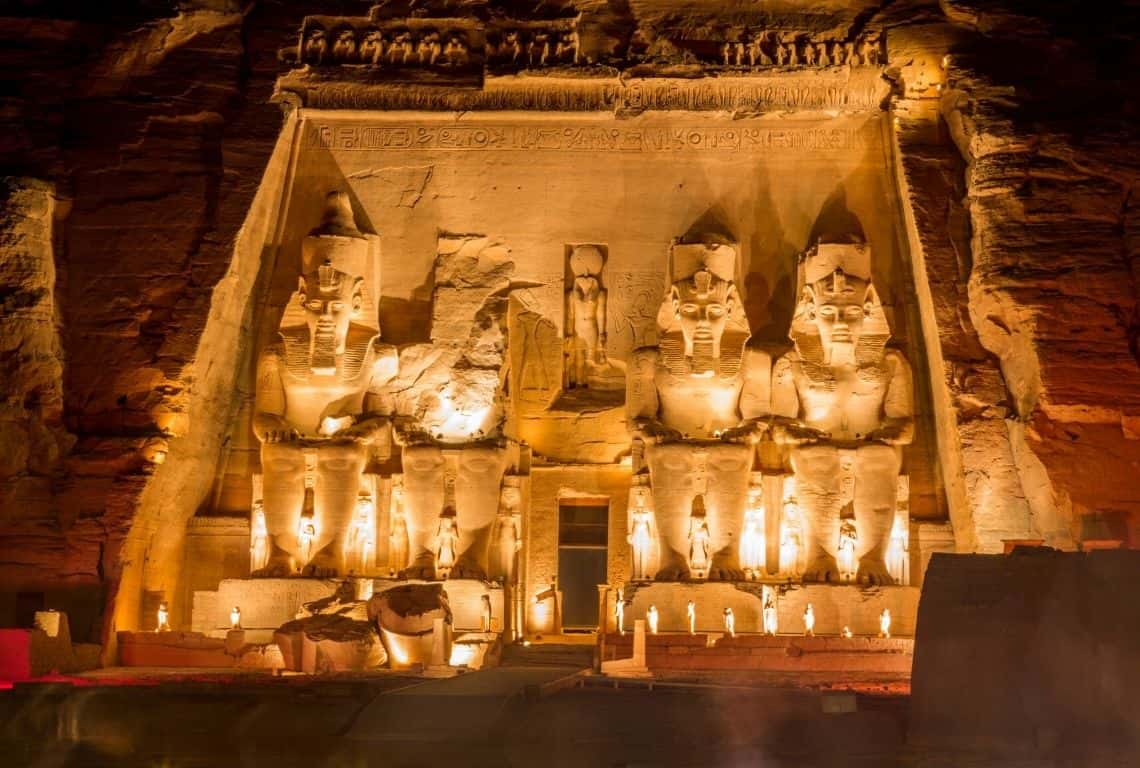
The Sound and Light Show at Abu Simbel / How to Visit and What to See at Abu Simbel
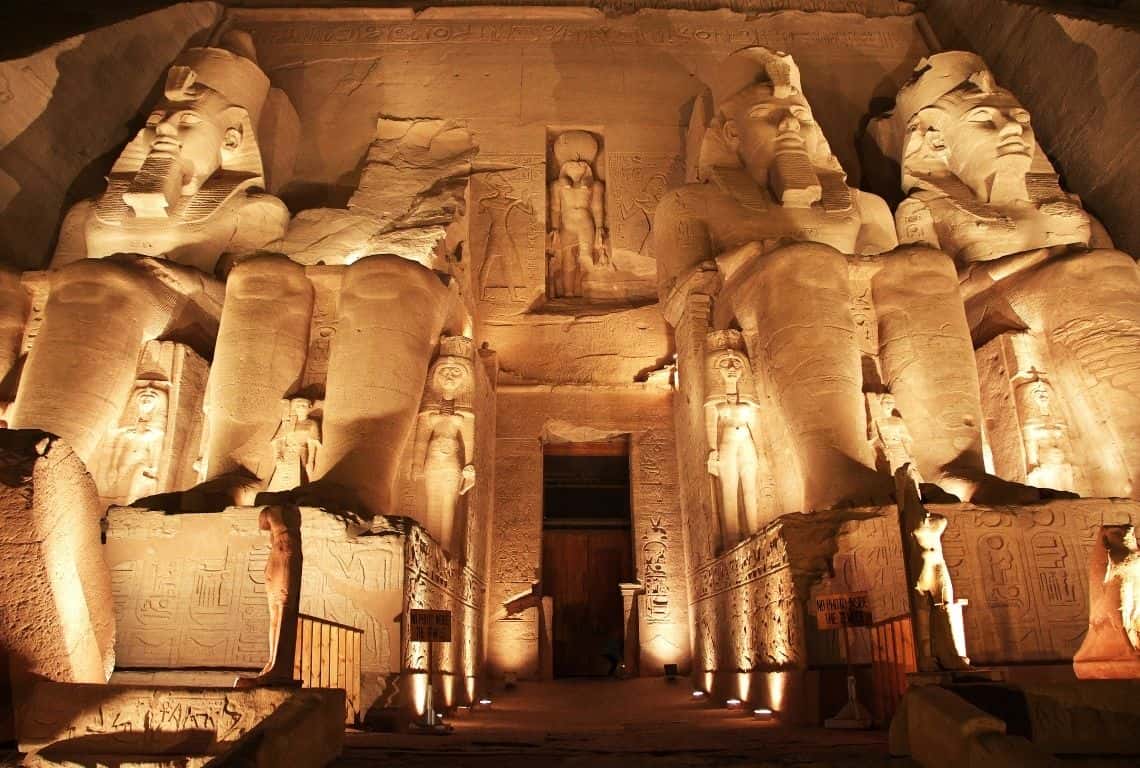
The Sound and Light Show at Abu Simbel / How to Visit and What to See at Abu Simbel
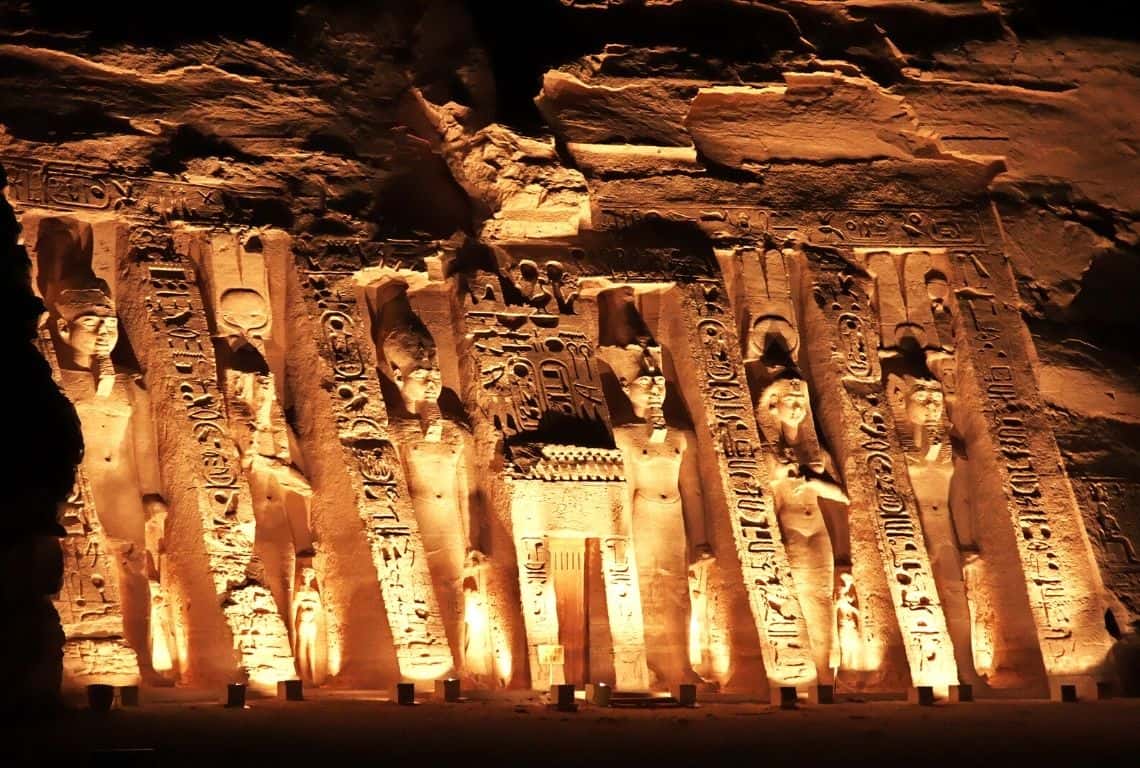
The Sound and Light Show at Abu Simbel / How to Visit and What to See at Abu Simbel
More Information About Egypt
How to Visit and What to See at KHAN EL-KHALILI BAZAAR in Cairo
Perfect 7-Day Egypt Itinerary for First Visit (Cairo, Aswan, Luxor, Abu Simbel)
What to See at the TEMPLE of HORUS at EDFU (5 Things You Can’t Miss)
10 Epic Things to See and Do at the Pyramids of Giza
What to See at the TEMPLE of KOM OMBO, Egypt (9 Things You Can’t Miss)
How to Visit Abu Simbel: Everything You Need to Know to Plan Your Visit
How to Visit and What to See at the TEMPLE of PHILAE in Aswan
Best Day Trip from Cairo – Dahshur, Memphis, and Saqqara (Maps+Photos)
Did You Find How to Visit and What to See at Abu Simbel Useful?
Why Not Save It to Your Pinterest Board!
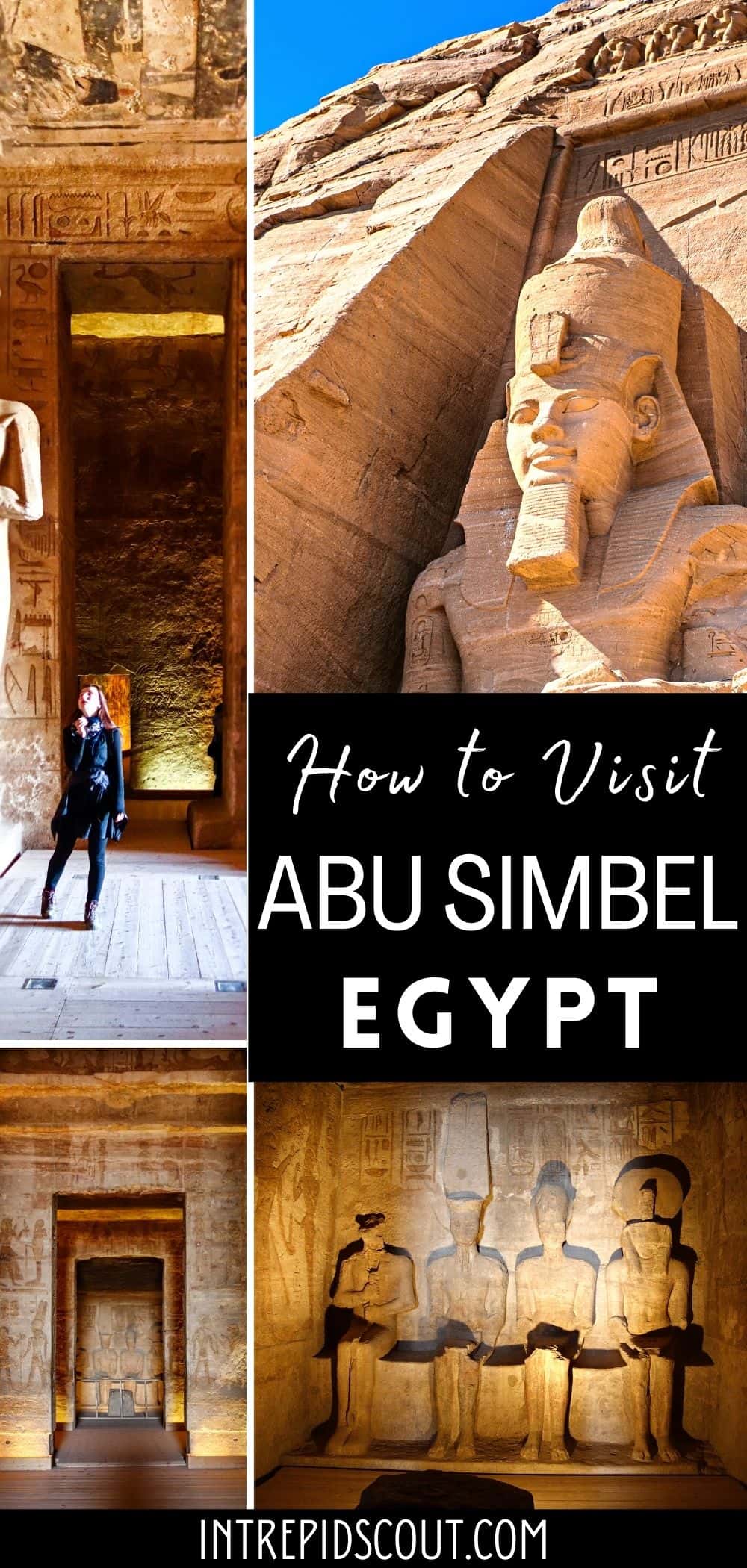
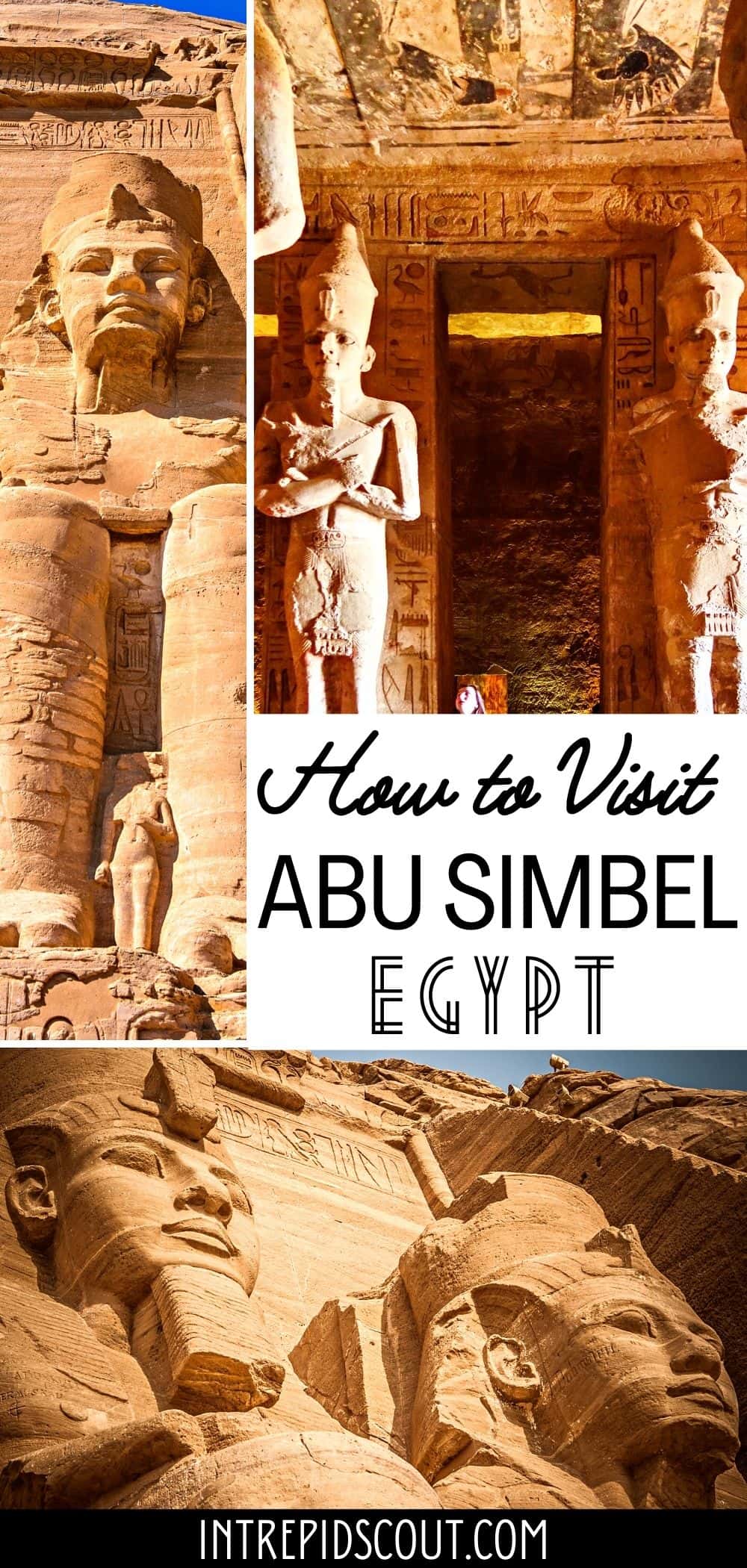
Now, It Is Your Turn, I Would Like to Hear Back from You!
Are you planning your trip to Egypt?
Please let me know! Drop me a quick comment right below!
Click on any of the images below to get inspired and to help you with the planning process for your trip to Egypt!
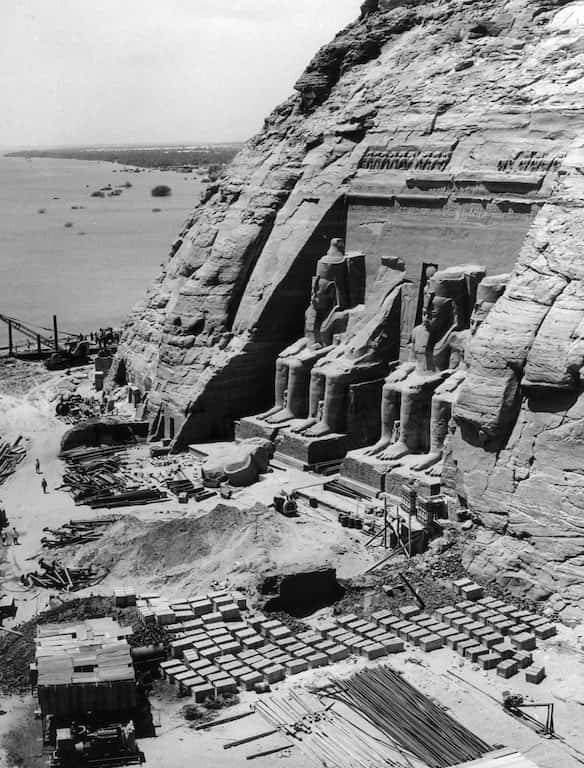
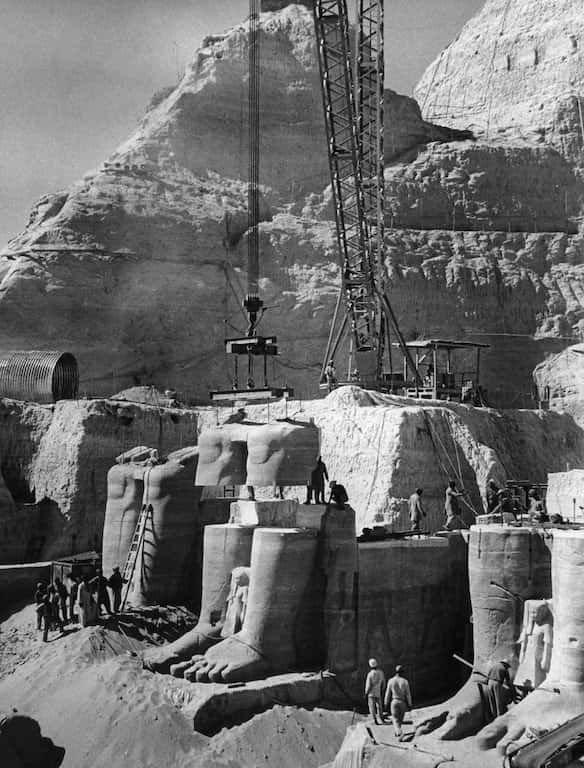
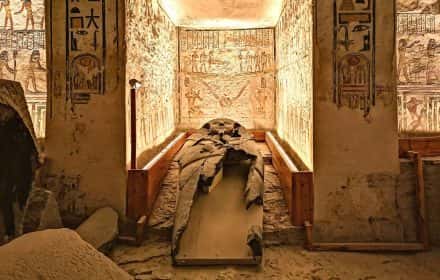
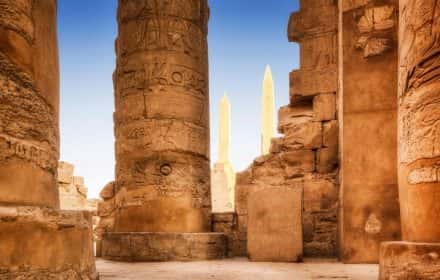
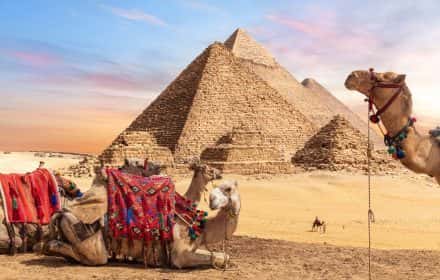
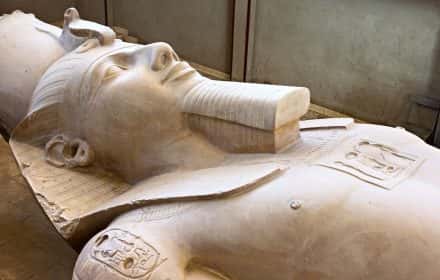
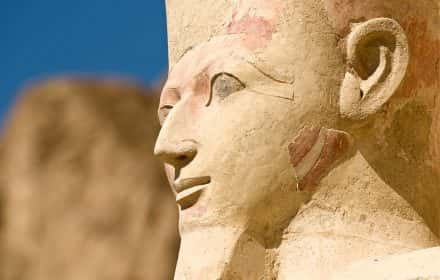
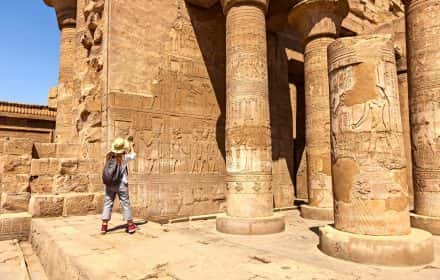
Comments:
31 thoughts on “How to Visit And What to See at ABU SIMBEL (9 Practical Things to Know)”
That is so interesting that this Great Temple of Abu Simbel was carved out of solid rock. Also, that 2x a year (2/22 and 10/22, sunlight reaches deep into the innermost room of the temple and illuminates 3 of 4 sitting statues. I wonder why not the 4th though?
Why do you think?
I’ve been to Egypt twice, but I’ve never visited any monuments! Shame, I know … Next time! 🙂 I will also think of Abu Simbel.
Great!
Such an informative travel guide. I really enjoyed all of your great photos!
Great!
I think I would take your advice and take a tour. You’re right all that time on a bus, you might as well learn something while you are traveling to and from.
I agree. Thank you for your comment.
I love how this had actual historic information rather than simply “this is the best place to go.” I feel like I learned so much!
Thank you!
So beautiful! I love the statues and artwork, great photos! Can’t wait until I can visit! Saving for future planning.
Thank you! Sounds great!
We were planning a trip to Egypt a few years ago and then the 2013 riots hit a few weeks before we were supposed to fly. At that time we cancelled our trip. Now, reading your post, it makes me want to resurrect our plans.
I experienced the same planning challenges. I had to wait as well. I am so glad it worked out.
Egypt is high on my bucket list! It is so cool that you can go inside here! I also can’t believe two huge stone temples were moved, seems impossible.
My visit to Abu Simbel was the highlight of my trip.
Squeeee! This would be SUCH an amazing trip! I would love to visit the Abu Simbel Temple Complex and see those amazing sculptures and carvings. I loved reading about the history too. What a fab post.
Josy,
Egypt is calling your name! You would love it!
I’ve never really known about any attractions in Egypt outside of the Cairo metro area, so it was really cool to read about the Abu Simbel Temples! The history of the creation of Lake Nasser as well as the relocation of the temples is truly fascinating. Your pictures are incredible, and as someone who took a random elective in college focusing on the linguistics of Middle Egyptian language, I would LOVE to see some of those hieroglyphs in person. What a treat!
You definitely should plan a trip to Egypt. You will really enjoy learning about the history, culture, inventions, oh, the list just goes on. By the way, I studied linguistics as well (English language), so I appreciated the insight into the hieroglyphs.
Even though the tour guide wasn’t allowed in, it sounds like having a live person share all that information with you before getting to the site would be worth it. I’ll keep that in mind.
Great! I am glad you found it useful.
Great!
I remember visiting Egypt as a child but I think I need to go back after reading this post!
Great! There has been so many new discoveries, that, I am sure, you will find it engaging.
Wow. That is indeed a detailed guide. It really helps a lot. It also literally gave a virtual visit to the place. Love it really!!!!!
Hello Jayashree,
Thank you so much for your comment! I am so happy you liked it.
Thank you again!
Which guide/travel organiser did you use? I’m trying to arrange this trip from myself and am getting wildly different prices and quality of service. Any tips would be gratefully received!
Hi,
I used Your Egypt Tours. I mention them several times in my posts about Egypt.
Take a look at 14 Egypt Tips for First Timers (How to Save Time, Money, and Be Safe), it will help with the planning process.
https://www.intrepidscout.com/egypt-travel-tips/
Hi, At what time did you start from Aswan to get to Abu Simbel and how long did it take to see the site and then return? We are planning a trip later this year and all the tours start from Aswan at 4am due to road closings in the area. Was this an issue when you visited?
I started at about noon. It takes about 2 hours to see the site. I got back to Aswan at about 8 pm.
There were no road closures, however, we had to stop at a few checkpoints. Things change all the time in Egypt. By the time you are in Egypt, there might be no road closures. Make sure to check with your tour company and ask them to keep you posted.